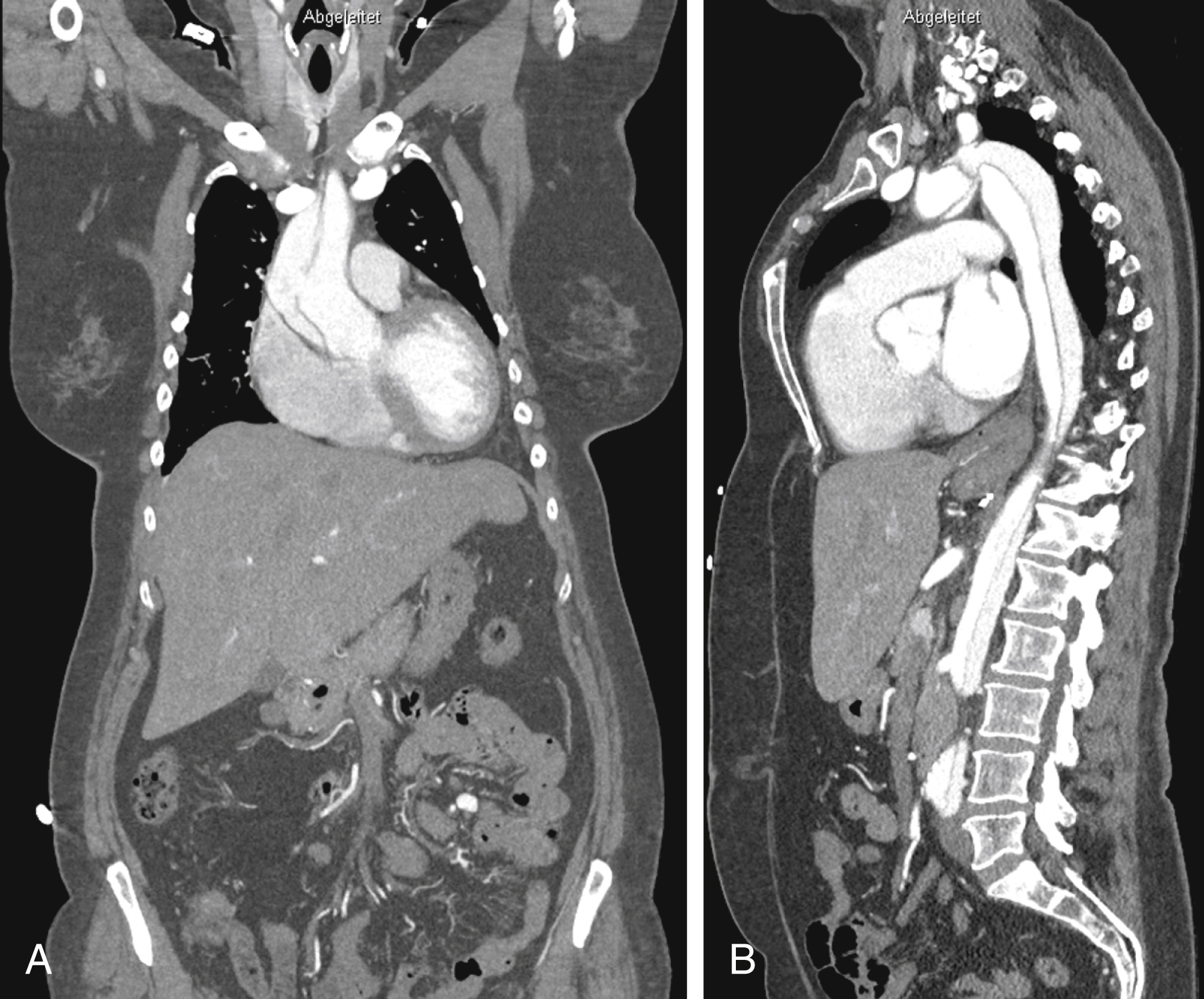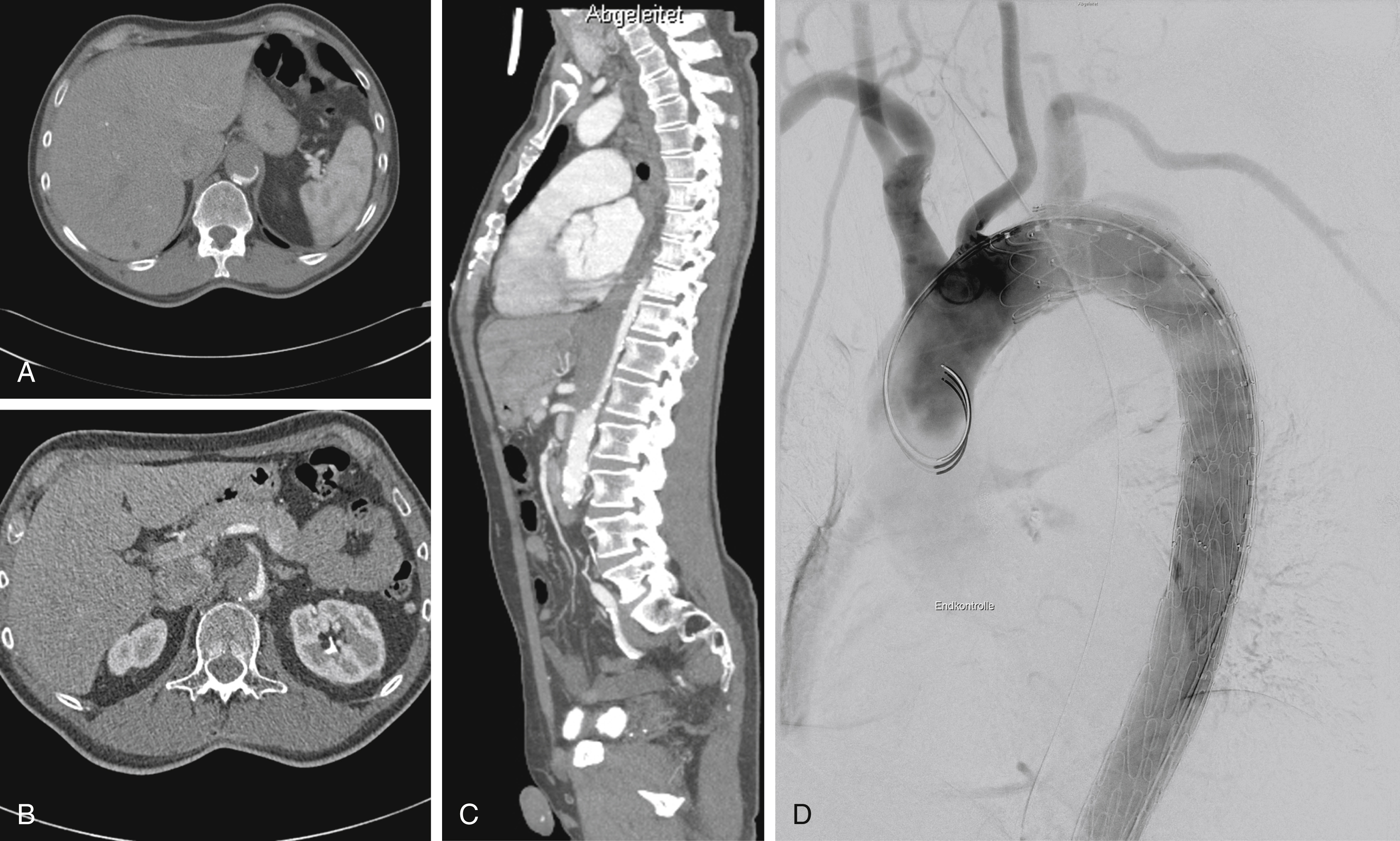Physical Address
304 North Cardinal St.
Dorchester Center, MA 02124
Acute aortic syndrome (AAS) is a modern term used to describe a constellation of potentially life-threatening aortic conditions, generally caused by disruption of or injury to the medial layer of the aortic wall. It can involve the thoracic or the abdominal aorta, or, in some cases, both. AAS is usually characterized by acute onset of severe chest/back/abdominal pain and may be accompanied by symptoms attributable to organ malperfusion such as acute onset hypertension refractory to therapy; acute anuria; bloody stools; cold, pulseless extremities; and paraplegia or paraparesis.
The acute disease is distinguished from chronic disease based on the point of initial clinical presentation or symptoms (hyperacute <24 h, acute 1–14 days, subacute >14– 90 days and chronic > 90 days). The three major entities comprising AAS are aortic dissection (AD), intramural hematoma (IMH), and penetrating aortic ulcer (PAU). One entity may evolve into or coexist with another. In this chapter we discuss each entity of AAS separately.
AD was first described by Morgagni in 1761 after the death of King George II of Great Britain. It is potentially life-threatening and has an incidence of 2.6–3.5 cases per 100,000 person-years. Approximately two-thirds of the patients involved are male, with a mean age of 63 years, whereas women present slightly later at an average age of 67 years. Patients with dissections of the ascending aorta tend to present at a younger age (50–55 years) than those with dissections of the descending aorta (60–70 years). Risk factors and conditions contributing to AAS are listed in Box 52.1
Male gender
Age >65 years
Long-standing hypertension
Smoking, cocaine/amphetamine abuse
Dyslipidemia
Coarctation of the aorta
Bicuspid aortic valve
Hereditary vascular disease
Connective tissue disorders
-Marfan syndrome
-Loeys-Dietz syndrome
-Ehlers-Danlos syndrome
Turner syndrome
Vascular inflammation
-Autoimmune disorders: giant cell arteritis, Takayasu arteritis, Behçet disease, Ormond disease
-Infectious: syphilis, tuberculosis
Deceleration trauma
Iatrogenic
-Catheterization/instrumentation
-Valvular aortic surgery
AD is characterized by blood dissecting between the layers of the media through an intimal tear, thus separating the intima from the adventitia and creating a true lumen (TL) and a false lumen (FL). Degeneration of the aortic media or cystic medial necrosis are believed to be prerequisites for the development of nontraumatic aortic dissection. Ascending aortic dissections are twice as common as descending aortic dissections. Many (50%– 65%) of the intimal tears occur in the ascending aorta, most commonly in the right lateral wall ( Fig. 52.1 ), whereas about 20%–30% of the intimal tears are located in the vicinity of the left subclavian artery. The predisposition of these two sites is hypothesized to be related to shear forces being highest in these regions.

The dissection can propagate proximally to involve the aortic valve and enter the pericardial space or branch vessels, leading to clinical manifestations, including aortic regurgitation, cardiac tamponade, or coronary ischemia. Extension into the supraaortic and thoracoabdominal vessels may result in cerebral, spinal, visceral. or lower limb ischemia.
Pain is the most common presenting symptom in more than 90% of the cases, usually in the chest and back. Chest pain radiating to the neck and jaw is predominant in type A dissections. Focal neurological deficits/altered consciousness due to stroke arising from dissection of the carotid arteries as well as signs of myocardial ischemia may be present. Involvement of the aortic valve may produce a murmur of aortic regurgitation. Chest and abdominal pain is prominent in patients with type B dissections. Impaired blood flow to the visceral and peripheral vessels can lead to refractory hypertension, an acute abdomen with or without bloody stools, and pulse deficit. Acute paraplegia due to spinal cord ischemia as well as syncope are the other presenting symptoms.
The two main anatomic classifications used to describe aortic dissection are the DeBakey and Stanford systems.
The most widely used Stanford system classifies aortic dissections that involve the ascending aorta as type A, regardless of the site of the primary intimal tear, and all other dissections as type B.
The DeBakey system classifies type I ADs as those originating in the ascending aorta and propagating to the aortic arch and descending thoracic/abdominal aorta, type II as those confined to the ascending aorta and type 3 as those originating in the descending aorta and extending generally distally or rarely proximally. Type III is subclassified into type III a (restricted to the descending thoracic aorta) and type III b (extending into the abdominal aorta).
Blood chemistry at presentation may show raised D-dimer and C-reactive protein levels. D-dimer > 500 μg/L suggests aortic dissection. However the marker is nonspecific because raised D-dimer levels may also be present in other conditions such as pulmonary embolism.
Routine primary investigations include an electrocardiogram, to rule out an acute coronary syndrome, and a chest radiograph. On the chest radiograph, widening of the aortic silhouette and a pleura effusion/hemothorax may be visible.
A transthoracic echocardiography (TTE) yields useful information regarding the valvular status and the ascending aorta. Especially in hemodynamically unstable patients as well as intraoperatively, TTE can be supplemented by transesophageal echocardiography (TEE). Together, TTE and TEE have a high sensitivity and specificity for detecting lesions of the thoracic aorta. Especially for the detection of intimal entry tears in AD, they may add valuable information to that gathered from computed tomography (CT) and may help circumvent transcatheter digital subtraction angiography (DSA) for this purpose. The shortcomings are the limited visualization of the aortic arch and of the abdominal aorta.
Because of a sensitivity of nearly 100%, contrast enhance multidetector CT angiography has become the method of choice as a “one-stop-shop” examination for the diagnosis and assessment of AAS. It has the advantages of ruling out nonaortic causes of the clinical symptoms (such as pulmonary embolism) and can cover the entire aorta and iliac vessels in one examination. Furthermore, it is ideally suited not only for establishing the diagnosis but also for planning the appropriate therapy. It is important to emphasize that thin-slice collimation and reconstruction thickness, preferably ≤1 mm, are essential for high-quality multiplanar and 3D reconstructions. Whether an unenhanced scan should precede the contrast-enhanced examination is a topic of debate; an unenhanced scan offers the advantage of being able to more reliably diagnose intramural hematomas and FL thrombosis.
Although magnetic resonance imaging is also a highly sensitive tool for detecting all forms of aortic pathologies, its practical use in an acute clinical setting is restricted by limited accessibility and the difficulties in imaging unstable patients in magnetic resonance scanners.
Catheter-based DSA as a diagnostic tool for AAS resulting from AD has become obsolete. However, during endovascular therapy, it may be of assistance in accurately locating the entry tear should this not be possible on preinterventional CT or TEE.
Medical management of acute AD includes intensive care unit monitoring of vital parameters (blood pressure, heart rate, etc.) and pain control. The target is to maintain systolic pressure of 100–120 mmHg and a heart rate of 60–80 beats/min to decrease aortic wall sheer stress. Beta-blockers are the preferred agents; however, additional antihypertensive agents are also often required. Furthermore, there is evidence that angiotensin-converting enzyme inhibitors have unique vascular remodeling properties. Management of pain may require a multiple-drug regimen, including opioids.
If untreated, mortality in the first 24–48 hours after the acute episode rises by about 1% per elapsed hour; more than 50% of the patients are dead by the end of a week. Hence type A dissections are as a rule treated by urgent open surgery. A detailed description of these surgical techniques is outside the purview of this chapter. An exception to this rule is retrograde type A dissection with a primary entry tear in the descending aorta. These respond well to endograft-mediated closure of the entry tear, which results in partial or complete regression of the dissection.
As opposed to type A dissections, the invasive management of acute type B AD is largely endovascular. The endovascular options available include stent-grafting for entry tear closure, TL stenting, and percutaneous endoluminal fenestration of the intimal flap. These options can be used as stand-alone options or in combination.
Indications for interventional management in acute type B dissections include:
frank rupture or impending rupture (rapidly expanding FL during the course of the hospital stay, increase in total aortic diameter >5 mm, often accompanied by persistent pain)
evidence of end-organ malperfusion
refractory pain despite adequate medical treatment
therapy-refractory hypertension
Whether uncomplicated type B dissections not fulfilling any of the above criteria should be treated invasively is presently a topic of ongoing debate without adequate consensus.
The rationale behind stent-grafting of the TL is to close the entry tear and cut off perfusion of the FL. This leads to thrombosis and shrinkage of the FL, thus reducing the risk of rupture or stabilizing an already ruptured FL.
The radial expanding force of the stent-graft in the TL combined with thrombosis and shrinkage of the FL lead to an expansion of the TL with resultant relief of end-organ malperfusion ( Fig. 52.2 ).

Become a Clinical Tree membership for Full access and enjoy Unlimited articles
If you are a member. Log in here